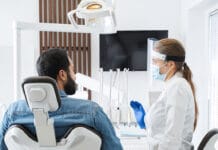Teledentistry has emerged in recent years as a transformative solution in dentistry. By utilizing telecommunication technology, this innovative approach has the potential to assist with oral health services for patients, including those with special needs. With its ability to overcome geographical barriers, enhance access to care, and improve oral health outcomes, teledentistry has become a helpful tool in supporting individuals with disabilities.
The applications of teledentistry in special needs dentistry can help bridge the accessibility gap while ensuring effective treatment and support. Traveling for patients with special needs can be challenging because of physical limitations or proximity to a dental office that works with special needs. Teledentistry can enhance the dental care experience for all individuals, but its effectiveness for special needs patients is worth noting – for example, those with autism, cerebral palsy, extreme mobility issues, or severe dental anxiety.
Teledentistry Overview
Teledentistry encompasses a wide range of technologies and techniques. The main objective is to deliver dental care remotely by leveraging telecommunication platforms. These platforms include video conferencing and digital imaging, which connect patients with dental professionals. A multitude of software platforms facilitate these functions. Some use live HIPAA-compliant video phone calls similar to the Apple app Facetime. In contrast, others utilize text-type conversations such as photos and videos that can be sent through chats or texts.
The technology reduces the need for physical visits and enables remote consultations, diagnoses, and treatment planning in some circumstances. For example, a teledentistry visit would suffice for a patient with special needs who cannot tolerate treatment where sedation would be advised. The dentist could note the patient’s inability to tolerate treatment and can treatment plan for sedation. Then, the full exam and radiographs can be completed under sedation. This teledentistry visit will eliminate the stress of the in-office visit for that patient.
This telecommunication technology and digital platform use strives to enhance access to oral health care, overcoming barriers preventing individuals from receiving timely dental services. Patients with special needs may fall behind on preventive visits due to the complexity of other medical visits and medical conditions competing for their time and ability to schedule. This may lead to emergencies arising due to delayed care or even accidents. Teledentistry allows access so that caregivers and patients can connect to the dental office to determine if an in-office visit is warranted or if a referral to a specialist is necessary.
Types of Teledentistry
The two types of teledentistry are synchronous and asynchronous. The American Dental Association (ADA) defines synchronous teledentistry as “Live, two-way interaction between a person (patient, caregiver, or provider) and a provider using audiovisual telecommunications technology.”1 Asynchronous is defined by the ADA as “Transmission of recorded health information (for example, radiographs, photographs, video, digital impressions and photomicrographs of patients) through a secure electronic communications system to a practitioner, who uses the information to evaluate a patient’s condition or render a service outside of a real-time or live interaction.”1
An example of asynchronous teledentistry is when a radiogragh or photo is sent to the dentist for evaluation. This is not a live interaction. It is evaluated at a later time, and subsequently, a response is sent back. Let’s say a patient with special needs falls, hits their lip, and has a large lesion. The caregiver can send a photo that they took to the dental office, where the dentist evaluates if this warrants further assessment and/or treatment. The dentist then sends a response to the caregiver once it is evaluated.
In contrast, synchronous teledentistry is when the dental professional, the patient with special needs, and the caregiver communicate live through a video chat. The caregiver can show how they are brushing the patient’s teeth and discuss any issues they are having with this task. The dental hygienist can evaluate and give recommendations on adjustments that need to be made or how they can overcome any issues.
The ADA has specific guidelines for teledentistry. Each state will also have specific laws that guide dental professionals on how it can be utilized in that state. Please check the guidelines in your state before implementing teledentistry.
Enhancing Accessibility for Patients with Special Needs
For individuals with special needs, accessing dental care can be challenging due to a variety of factors, including physical, cognitive, and sensory limitations. Transportation barriers, anxiety, and a lack of specialized providers further exacerbate the issue.
Teledentistry may be able to address these challenges by bringing dental care directly to the patient’s location. While the patient is not able to have a prophylaxis, periodontal probing, or radiographs done at home themselves, limited evaluations, oral hygiene instruction, and evaluations are possible.
Through video conferencing, patients can connect with dental offices, eliminating the need for travel. This allows for a reduction in anxiety associated with unfamiliar environments. This can allow the patients to have a virtual tour to become more familiar with the office and meet the dentist and dental hygienist outside of the dental setting, giving them a chance to become familiar with them in an environment they feel safe in, their home.
These preliminary visits can make the first in-office visit more successful. Travel can be difficult for patients with special needs. These in-person visits can be difficult for the patients and caregivers and cause treatment delays. This virtual approach ensures that individuals with special needs receive timely and convenient dental care by eliminating the need to travel for the first few “get to know you” visits. Their first in-office visit can often start with preventive treatment.
Improved Care Coordination and Collaboration
Teledentistry promotes seamless collaboration and care coordination among dental professionals, caregivers, and other health care providers involved in the treatment of patients with special needs. Often, patients with special needs are referred to another office for more specialized treatment. Or, they aged out of a pediatric office and have previous or even current imaging and treatment plans that can be shared with the new dental office.
The dental team can collectively assess the patient’s oral health status and develop personalized treatment plans by sharing real-time information, images, and dental records.
This collaborative approach between caregivers, patients, and the dental team ensures that all stakeholders are actively involved in decision-making, resulting in comprehensive, patient-centered care. Teledentistry can speed up the access caregivers and patients have to the dental team with photos and live visualization of possible dental issues. This also can eliminate the need to travel if an in-office visit is not deemed necessary.
Remote Monitoring and Support
Regular teledentistry visits can allow dental professionals to track treatment progress remotely in certain cases. For example, a patient who uses disclosing tablets to evaluate the effectiveness of home care or soft tissue lesions can be monitored through visualization, which can provide timely guidance to caregivers.
Having a televisit at a set time after initial guidance on using an electric toothbrush allows for evaluation of the technique and making recommendations for any fine-tuning of the method that may be necessary. Through regular virtual check-ups, dental teams can identify any issues promptly and intervene as necessary by either scheduling an in-office visit or referring to a specialist as needed, reducing the risk of dental emergencies and avoiding unnecessary hospital visits.
Tailoring Teledentistry to Patients with Special Needs
To maximize the benefits of teledentistry for patients with special needs, dental professionals must consider specific considerations and adaptations:
Sensory accommodations: Patients with special needs may have sensory sensitivities that require accommodations during virtual consultations. Lighting, audio, and visual elements can be adjusted to create a comfortable environment. The patient will experience less anxiety and sensory overload than they would in the dental office setting.
Visual communication tools: Visual aids and simplified language during virtual consultations can help individuals with cognitive impairments understand oral health instructions more effectively. Visual aids utilized in virtual visits are typically the same as those used at in-office visits. Teledentistry visits allow the caregiver and patient to be in the familiar environment of their home, which often lends to a better learning environment.
Caregiver training: Teledentistry can be an opportunity to provide caregivers with specialized training and guidance on oral care techniques, ensuring consistent and effective care for patients with special needs between dental visits. Teledentistry allows for re-evaluation of the caregiver’s techniques, as traveling with a special needs patient can be difficult.
Accessible technology: Dental practices should prioritize the use of user-friendly and accessible technology platforms to ensure seamless communication and engagement with patients with special needs. Demonstrations with different software platforms will allow the dental office to see what best fits their needs.
Accommodating physical limitations: Teledentistry platforms should be designed to accommodate patients with physical disabilities, allowing them to participate in virtual consultations comfortably. These platforms should allow for use on cell phones or tablets with Zoom capabilities. Hands-free options would allow the patient to put their device in a stand so that their hands are free to retract or point to a specific area. Simple-to-use platforms are ideal so that instructions on use are easy to understand.
Future Potential of Teledentistry
The future of teledentistry holds exciting prospects for further advancement and integration within the dental field. Innovations such as artificial intelligence, virtual reality, and augmented reality have the potential to enhance teledentistry’s diagnostic capabilities and improve patient outcomes.2
Additionally, ongoing research and collaborations between dental professionals, technology developers, and policymakers aim to refine telecommunication platforms, address challenges, such as privacy, visualization, lack of hands-on and reimbursement issues, and expand teledentistry’s reach to benefit more individuals worldwide.
Teledentistry holds immense potential in transforming dental care for patients with special needs. Teledentistry ultimately leads to improved oral health outcomes for these patients. Caregivers play a crucial role in supporting teledentistry by actively participating in appointments and ensuring consistent oral care for their loved ones with special needs.
With its ability to bridge the accessibility gap and overcome various challenges, teledentistry is revolutionizing dental care for patients with special needs. The ongoing advancements in teledentistry promise a future where virtual dental care becomes integral to oral health care, benefiting individuals of all backgrounds.
Before you leave, check out the Today’s RDH self-study CE courses. All courses are peer-reviewed and non-sponsored to focus solely on high-quality education. Click here now.
Listen to the Today’s RDH Dental Hygiene Podcast Below:
References
- ADA Policy on Teledentistry. (2020). American Dental Association. https://www.ada.org/about/governance/current-policies/ada-policy-on-teledentistry
- Thalib, B., Nurrahma, R., Asmawati, A., et al. The Use of Teledentistry and Artificial Intelligence (AI) in Dental and Oral Health Services for the Elderly in the Era of the COVID-19 Pandemic: A Systematic Review. Journal of Dentomaxillofacial Science. 2022; 7(3): 135-140. https://jdmfs.org/index.php/jdmfs/article/download/1406/851












